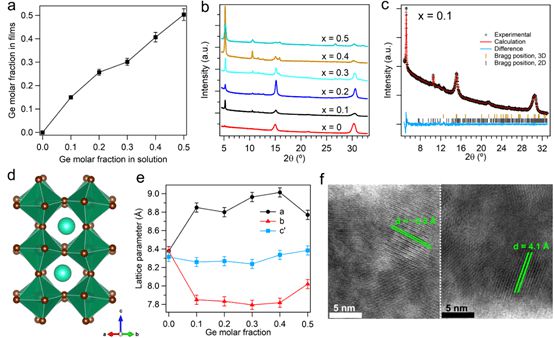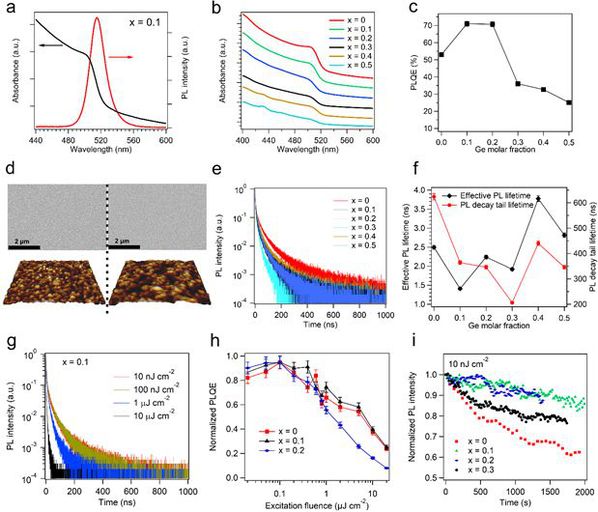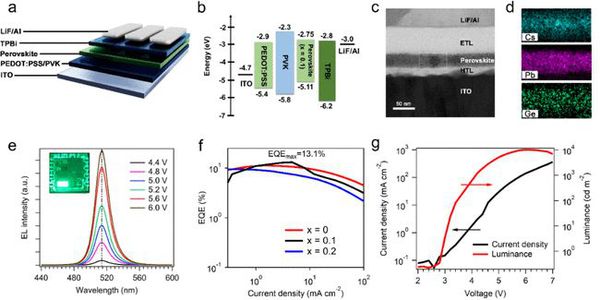Metal-halide perovskites are a new class of semiconductor materials for LED display and solar-energy harvesting. However, the best-performing devices are often made from lead (Pb)-based perovskites, whose toxicity may cause potential environmental concerns. To resolve the toxicity problem, an effective method has been the use of tin (Sn) as a partial or full replacement of lead in the perovskite materials. This strategy has been particularly successful for perovskite solar cells. However, tin-based (including tin-lead) perovskite materials are generally very poor light emitters, causing unsatisfactory performance of tin-based perovskite light-emitting devices (LEDs).
A reason for this is that a high density of electronic defects can form during the preparation process of tin-based perovskites, as tin (Sn2+) can oxidize and the crystallization process is not well controlled. Tin-based perovskite LEDs with external quantum efficiencies of 5% were reported in 2020. But these efficiencies were only possible at low brightness (38 cd/m2), well below the requirement for display applications (500-1000 cd/m2).
Recently, a research team led by Prof. DI Dawei from the Zhejiang University College of Optical Science and Engineering discovered that by using germanium (Ge), an environmentally friendly group-IV element, to partially substitute lead in the perovskite, it is possible to create highly luminescent perovskite materials and devices. A related paper entitled "Germanium-lead perovskite light-emitting diodes" was published by the team on July 13 in the journal Nature Communications (Nat. Commun. 12, 4295 (2021)).

Structural properties of germanium-lead perovskite samples (Source: Nature Communications)
"In our journey toward low-toxicity perovskite LEDs, we've been searching for alternative environmentally friendly metals to replace lead," said Di. "it was a pleasant surprise that germanium, the element between silicon and tin (on the periodic table) could perform so well as a substitution of lead for LED applications."
Dr. YANG Dexin, a postdoctoral research fellow in Di's group and the first author of the paper, said "we used to study the effect of germanium ions (Ge2+) in germanium telluride alloys (Phys. Rev. B 93, 144109 (2016)), and found that germanium ions may offer some benefits in terms of defects passivation."

Optical properties of germanium-lead perovskite samples (Source: Nature Communications)
The germanium-lead perovskite thin films showed high photoluminescence quantum efficiencies (PLQEs) of up to 71%. This was a relative improvement of about 34% over similarly prepared Pb-based perovskite films. The high luminescence efficiencies came from the enhanced radiative processes and reduced defect densities in the germanium-lead perovskites.
Using these materials, Di and colleagues demonstrated germanium-lead perovskite LEDs for the first time. "In our initial demonstration, we achieved external quantum efficiencies of up to 13.1% at high brightness (~1900 cd/m2) with a maximum brightness of over 10000 cd/m2. This was an efficiency record for reduced-toxicity perovskite LEDs," said Yang.

Measurements of germanimum-lead perovskite LEDs (Source: Nature Communications)
"While further work is certainly needed for improving the device performance and stability, our results suggest a promising route toward eco-friendly light-emitting technologies based on perovskite semiconductors," said Di.
Source: College of Optical Science and Engineering, Zhejiang University






